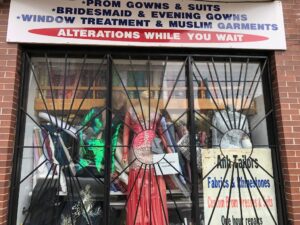 Philadelphia is one of those cities that still have neighborhoods defined by trade. We have the famous Jewelers’ Row off 8th Street, although some stores have been demolished to make room for a high-rise condominium. Never mind that its construction has been stalled due to the pandemic, leaving an ugly open wound fenced by barbwire. It seems that Fabric Row along 4th Street, between Bainbridge and Catherine, has fared a lot better in its transition to gentrification.
Philadelphia is one of those cities that still have neighborhoods defined by trade. We have the famous Jewelers’ Row off 8th Street, although some stores have been demolished to make room for a high-rise condominium. Never mind that its construction has been stalled due to the pandemic, leaving an ugly open wound fenced by barbwire. It seems that Fabric Row along 4th Street, between Bainbridge and Catherine, has fared a lot better in its transition to gentrification.
Fabric Row is over a hundred years old, started by Jewish immigrants who sold textiles and dry goods in curbside pushcarts. Eventually, they settled there, building rowhouses with their own storefronts. On a recent visit, I noticed that there were fewer and fewer fabric stores and more trendy boutiques, with some restaurants and tattoo parlors.
Growing up in Madrid I was aware that there were certain parts of the city well demarcated by its stores too. One had to go between Puerta del Sol and Plaza Mayor to look for religious holiday decorations, and Nativity sets, something that my family was not really into. My mother and I would go to Pontejos, a small, not-well-known plaza nearby, to look for fabrics and “mercerías” a word that isn’t used anymore, like its counterpart in English: “sewing notions.”
There were a set of traditions and rituals around sewing clothes in my family. Almost every week a “costurera,” (a seamstress) would come to make sheets, kitchen linens and children’s clothes. She would sit at the Singer machine in the family room, making a racket all day. My mother kept an eye on her while she embroidered initials and put the finishing touches on our garments. But when my mother needed a dress or a suit, she would go to Pontejos first to find the appropriate fabric. Then, she went to a dressmaker on fancy General Mola Street (Príncipe de Vergara since Franco died, when the streets were renamed back to their original names). I often accompanied her on those expeditions to the dressmaker. There were catalogs with patterns, fabric swatches and full-length mirrors everywhere. I liked sitting on a low stool and playing with the marking chalk and the colorful pins.
I remember an expression that defined how we dressed in those times. It was to have “quita y pon,” one piece to take off and one to put on. Thus, I had two uniforms, two pajamas, two Sunday dresses and so on; one to wear, while the other was being washed. There were all sorts of transformations too. My mother’s dress would turn into a skirt for me; her sundress would become an apron for the cleaning woman. My father’s trousers and jackets converted into a suit for my brother while he still wore short pants.
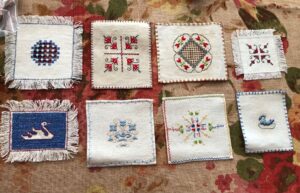 I learned to sew in school. I have kept the cross-stich samples and many other fancy embroideries I made as a child. My favorite project was to make a “canastilla,” a complete set of clothes for the baby –notice how we were being indoctrinated to be perfect housewives and mothers! I have to admit that all this sewing came in handy when I was a Marine Corps wife. For years I made all my clothes and my daughters’ as well. I even ventured with a formal gown for the Marine Corps Ball and silk ties as Christmas gifts, a tricky task.
I learned to sew in school. I have kept the cross-stich samples and many other fancy embroideries I made as a child. My favorite project was to make a “canastilla,” a complete set of clothes for the baby –notice how we were being indoctrinated to be perfect housewives and mothers! I have to admit that all this sewing came in handy when I was a Marine Corps wife. For years I made all my clothes and my daughters’ as well. I even ventured with a formal gown for the Marine Corps Ball and silk ties as Christmas gifts, a tricky task.
Now I go to Fabric Row in Philadelphia to look for upholstery fabrics. Occasionally, I make table linens or buy fancy buttons, another fetish of mine. This last time I met an old friend for lunch, Marisol, who lives in that neighborhood. It was a rainy fall day full of nostalgia.

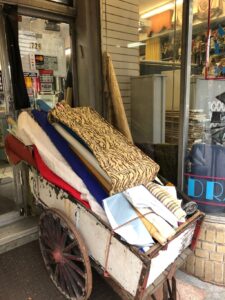

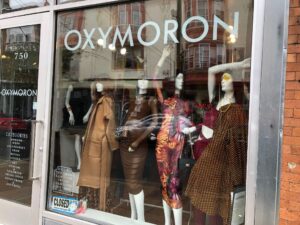
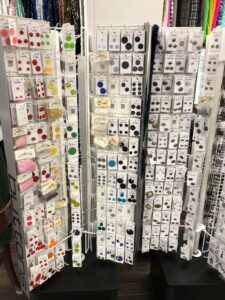

Me ha encantado esta entrada de tu blog, Concha. Me ha ayudado a recordar muchas cosas de mi infancia, muy cercana a la tuya.
Es un escrito lleno de vida, de color y de nostalgia
¡Inés, mi querida compañera de colegio! Tengo muchas ganas de verte y de pasear contigo por las calles de Madrid.
Un fuerte abrazo hasta entonces, Concha